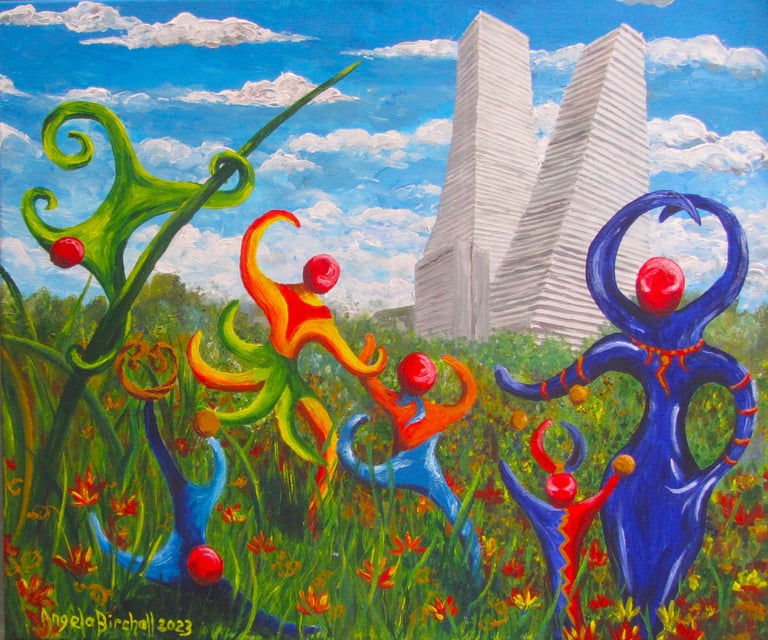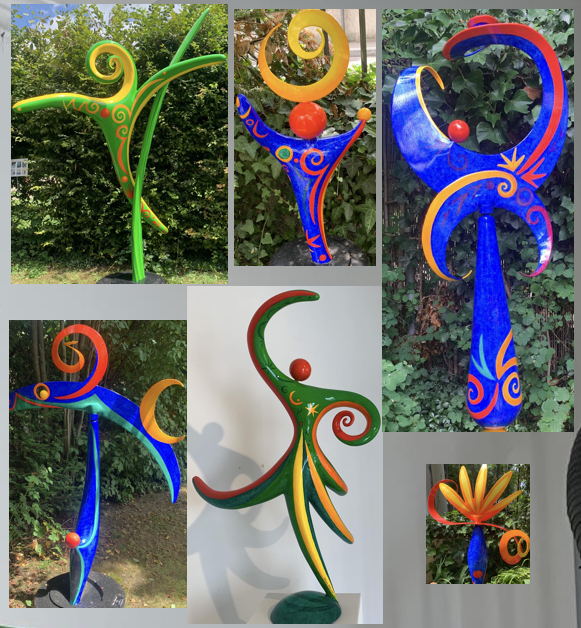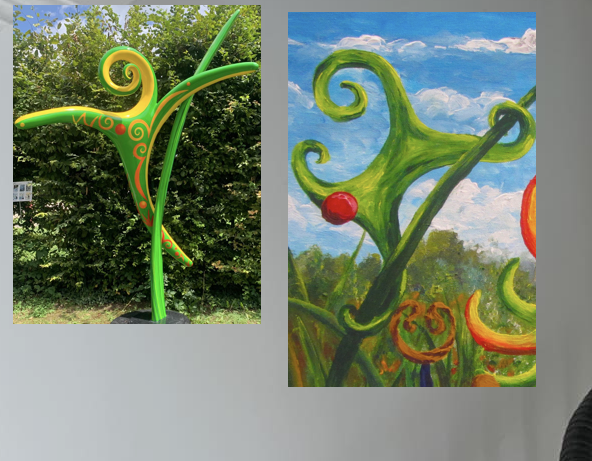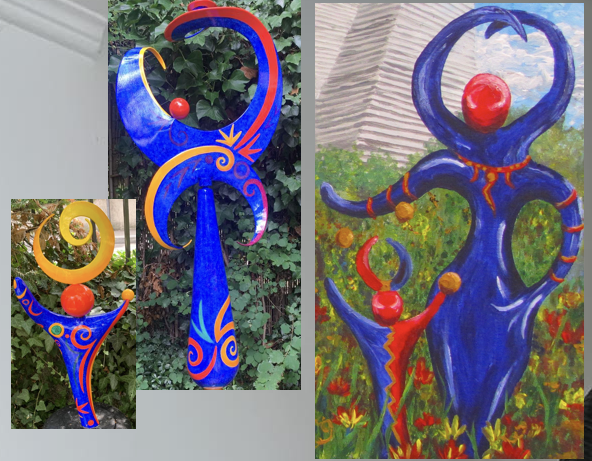How to have your ideal artwork created for you - explaining the commissioning process
When your favourite patron sees a mass of abstract metal sculptures and imagines how much fun it would be if they were figures leaping across a field in Basel in Switzerland, what happens? Simple: you turn them into a painting for her growing collection of your artwork. The process, is rather more complex than that ‘simple’ answer but it’s a great example of the commissioning process and how an artist works with a patron to turn their ideas into reality.
ASK ABOUT ART: READERS' QUESTIONS
Angela Birchall
11/30/20239 min read


When I’m creating my own choice of artwork anything and everything could be the sparks of inspiration that are my starting points. When I am being commissioned to create artworks for someone, it is totally different but still an absolute joy.
So many people that I speak to have no idea how the commissioning process works so they avoid the situation and, as a consequence, never get the original artwork that they would love to have hanging in their home.
I have just completed a commission for my favourite patron so let me show you the commissioning process through the example of this particular artwork.
During the summer she had seen examples of abstract metal sculptures designed to be placed in garden settings or, the smaller ones, inside a home. She loved the bright colours and the bold shapes and started to mull over the possibilities . . .
The weeks passed and she thought about them time and again and began to imagine how much fun it would be if, instead of being static metal sculptures, they were figures leaping across a field.
As she had previously commissioned me to bring a sculpture she had seen “to life” on a canvas, she knew that her next step was to send me a batch of photos with that initial idea of the figures skipping through a field.


I looked through the photos (there were twice as many as I have shown above) and we bounced some ideas back and forth each time clarifying what she wanted and whether and how it could be achieved.
She later explained to me that the sculptor was Swiss and that she’d seen them when she was working in Basel in Switzerland, so she thought of another element and wondered if that could be added in.
Basel has two iconic tower buildings, the Roche Buildings, and she could see them from the apartment where she was living. So she asked for them to be added in to the scene.
It is in this discussion stage where the success – or failure – of the commissioning process primarily occurs. As the artist I have to be as clear as I possibly can be just what the image is in the mind of my patron. If not, it will only be by good luck that the finished artwork matches that image. Thus, my empathy with my patron, along with intuition and imagination become as important to the success of the finished work as my creativity and skill as a painter . . . spending many years as a journalist can also help to ask the right questions to get things clarified.
Having worked together quite a few times now, Susie does trust me to turn her ideas into finished artworks, but I still want to be as clear as I can be as to what she is visualising the finished work will look like. Working with someone on a first commission, I would have been asking ten times as many questions for a commission as unusual as this one.
My first commissions for Susie were pet portraits and they are much more straightforward to establish the requirements for – e.g. is it just head and shoulders or full body; is the reference photo a good representation of the fur colour; with or without a background; any items added or subtracted from the reference photo; what colour background, etc.
Other commissions could be taking photos of places with special memories and turning them into finished artworks and the additional questions would be around any special emphasis, lighting effects, seasonal elements, additional items or things to delete, etc.
Anyway, back to the skipping sculptures.


The first point that I had to bear in mind was that I’m using someone else’s artwork as a starting point so it can’t be a direct copy. However, the painting still has to capture the sculptures’ qualities and characteristics that attracted her to them in the first place. If the figures in the final painting don’t remind her enough of the pieces which sparked her desire for a new artwork then it will not be a success. This is why it is crucial to establish a high level of empathy with your patron.
Next I had to take the ‘figures’ from being rigid, abstract metal sculptures and morph them into characters that could be playing in a field. They still needed to be abstract figures rather than realistic human figures, but they had to be closer to fluid, flowing forms than the rigid metal pieces in the photographs.
I went through the pictures over and over again looking at them and narrowing down the selection shown earlier on. Some were slightly more like the figures I wanted and I began to see how I could morph them into actual characters. In fact, they virtually took on personalities of their own as I decided on what sort of activities they could be taking part in as they played in the field.
That then led to establishing their relationship to one another. Susie’s initial idea had been to have figures skipping through a field so they became the two figures skipping through the middle of the painting. Of course, when I am working on the composition of a painting or drawing I don’t want the main focal point to be right in the middle of the canvas. Instead, I want to work on placing elements on the horizontal and vertical thirds and have S-shapes or curves coming through the picture in order to lead the viewer’s eye around the scene.
Success or failure of the commissioning process
The selection of sculptures that I worked with.
The skipping sculpture and the 2 skipping figures from the painting
With the Roche towers being in the background, I didn’t want them to be the only tall element or it could cut the image in half horizontally. The obvious tall element from the sculpture photos was a figure that looked like it was doing some form of pole dancing. Translating pole dancing into a field setting means that the figure has to be dancing on some sort of leaf or twig.


The 'pole dancer' sculpture and the one from the painting
One of the sculptures that had caught my eye was a very elaborate one so that was going to dominate the scene both in size and its dark blue colour standing out against the white/grey of the Roche buildings and the greenery of the field. In a similar colour scheme was perhaps the most simplistic of all the figures with its arms just reaching upwards. I liked the placement of the two together not just because of the contrast of their complex and simplistic shapes but because it gave me the feeling of a child with parent/carer/mentor proudly showing off their offspring/charge.
Because Susie, my patron, works with children it would become representational of her and her work. I did adjust the basic ‘body’ shape of the figure into a more curvaceous feminine form and turned the arms/hands out as if she was drawing your attention to the little figure.
I scaled down the simplistic figure to stress the adult/child proportions and whereas one of the arms of the small figure sculpture has a golden circle attached to the end, I developed that in the painting into three golden balls that were being juggled in the air.


The two sculptures turned into adult and child in the painting
There was space for one more sculpture in the scene. I wanted it to link different elements already in the scene and balance the figures and movement. There are the two figures skipping through the field, the two figures of the adult and child, but just one figure flipped upside down with the leaf/pole dancer. So I chose one based on a sculpture that reminded me of a figure upside down and juggling different objects on its feet – I think I was coming out in sympathy with him juggling different things!
The description above of the compositional process doesn’t go through all the different iterations, nor does it recount all the permutation of figures that I sketched out en route, just the final answers that I came up with but it gives you the gist.
With the selection of figures and their relationship to one another and the overall image sorted and sized it was heading towards starting the actual painting. The most important questions still to be answered centred around the colours of the figures and how to include them in a natural setting.
The originals were mainly painted in single, bright colours with decorative patterns stamped onto their forms. I wanted to keep their bright colours but lose the patterns as they could flatten out the images too much. Also, to put them within a natural setting of a field they needed a consistent source of light and shade so that would give them the appearance of 3D shape and form.
Looking at the photos of the abstract sculptures, some of them have a sort of red sphere that takes the place of the head while others just have a red dot within the patterns painted onto the figures. With morphing them into skipping, dancing, juggling figures I did want them all to have a consistent form of head shape but I didn’t want them to include hair or facial features. By using light and shade to create a 3D sphere rather than a flat red disc or dot it does give them a fleeting resemblance of faces but I’m still keeping them within Susie’s brief of abstract figures brought to life.
The foreground is full of flowers based on the shape of a single flower sculpture but with a lot more movement in the forms. The flowers, grasses, plants and shrubbery fade off into the distance becoming the trees in front of the white/grey Roche buildings which drift off into the white/grey clouds
Only then do I start the actual process of painting the canvas. I’ve lost count of how many changes there were to the costumes and colours of the figures before I ended up with what I hoped was the final version. Whether or not it is the final version depends on how well it has recreated the hoped-for image in my patron’s mind. I always get to the stage where I’ve got as close to what I think that image is before I send them a photograph of it . . . if I’m still not sure of different aspects I will discuss the issues until I’m as clear as possible as to what they want.
Then I attach the photograph, press ‘send’ and wait with baited breath.


Back came the response: “Oh my god! That is absolutely blooming amazing! My stomach has butterflies! Gosh you are absolutely incredible!”
A broad smile spreads across my face. I know that I have hit the mark and I can now put the final touch to the canvas . . . my signature.
That’s an example of how someone can have an idea for a unique artwork that will mean so much to them and will trigger so many memories every time they look at it. She could have trawled hundreds of art galleries either online or anywhere in the world but would never have found a picture like that. That’s the real beauty of commissioning your own bespoke artwork. It is unique. You first think of an idea and then have that dream translated into an actual canvas to hang in your home, office or business.
If you are going to go down that route then there will also be other considerations for you to think about before you go ahead. Even before you choose the artist, you want to think about the size of picture you want. You know the place in which you want that picture to hang so you decide the size range you will need it to fit within. Also consider whether it is going to be a single image or become a collection of them. For instance, if you were looking at a portrait of a person or a pet, is it just one portrait or will you be collecting a number of them over time? If you are going for multiple pictures then you can opt for smaller images than if you were filling that space with just one picture.
The size of the picture will obviously affect the price and only you can know the budget that you have available. That will also be a consideration for you in choosing the artist you select to undertake the commission. Then there’s things like the medium used to create the painting or drawing, the style, colours, etc, etc. In future Picture Perfect blogs I will dive deeper into these considerations then you can find the artist you are in sync with to turn your ideas into a unique piece of artwork especially for you that you will treasure forever.
Remember, if you have any art questions that you would like answered in a future Picture Perfect blog post, get in touch using the message box below.
Get in touch
Use the message box to drop me a line if you want to:
purchase my paintings or drawings;
discuss commissioning me to create a unique work of art especially for you;
have a question to be answered in a future Picture Perfect blog post;
join one of my face-to-face painting or drawing classes in West Lancashire or have private coaching online;
discuss a bespoke staff development event using art to encourage teamwork and leadership
Contacts
0044 77242 00779
youcandrawandpaint@gmail.com

